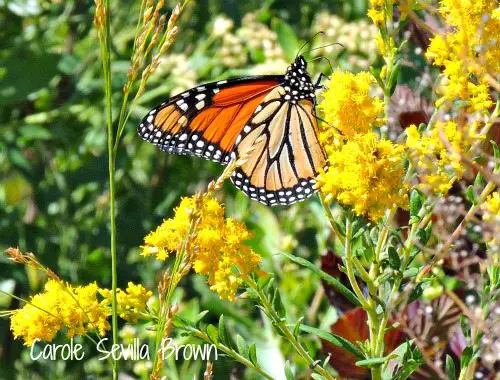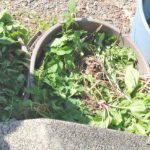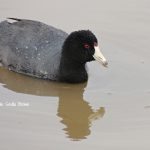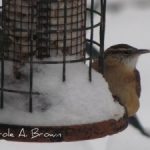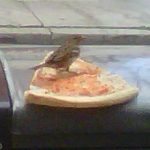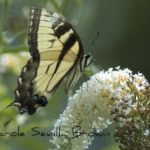The Monarch Butterfly has been much in the news lately as we receive the devastating news that the current wintering population in Mexico is at all time low.
There are many reasons for this decline in Monarch Butterflies:
Current agricultural practice
Genetically modified crops
Pesticide use
Loss of habitat
Destruction of larval host plant by Roundup and other weed killers
But despite all this doom and gloom, there is still hope!
Your wildlife garden, no matter how small, can become part of a network of connected gardens around the country that are restoring or creating habitat for this beautiful butterfly.
I have written many articles about the Monarch Butterfly, as have my team members at Beautiful Wildlife Garden and also Native Plants and Wildlife Gardens.
So, in order to make this library of resources easier for you to find, I’m going to collect them all here for your reading pleasure.
Monarch Butterflies in Trouble
Saving the Monarch Butterfly
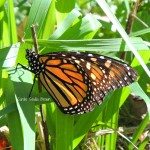
The Monarch Butterfly is in deep trouble, and many passionate organizations have been created to save this single species. But a focus on protecting habitat instead of concentrating on a single species will provide lasting benefits for all species of wildlife and the native plant communities that support them, a far more worthy effort to many environmentalists and wildlife gardeners. ~ Carole Sevilla Brown
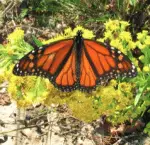
The Monarch’s Breadbasket
Nowadays, approximately 90% of corn and soy seeds are genetically modified. Now farmers can use Roundup freely on these resistant crops. This radical change in farming practices is having unpredictable impacts in ecosystems. One effect of herbicides used in this manner is that it finally became possible to wipe out populations of common milkweed that previously had managed to prosper in cultivated fields and along field edges. What is good for the farmers may prove devastating for the monarchs. According to some recent studies, most of the monarchs in Canada and the East Coast (fourth and fifth generations) are descended from the ones born in the Corn Belt… ~ Beatriz Moisset
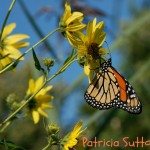
Where Are The Monarchs?
I have been asked this question countless times this year. As I write this and stroll through my wildlife garden for inspiration, a have a rare sighting – a Monarch nectaring on Giant Sunflower. This year every single Monarch sighting is precious. They’ve been scarce for me and every other wildlife gardener I know. It seems everyone I come into contact with has also noticed their absence…. ~ Pat Sutton
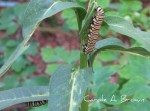
Monarch Butterfly Wintering Population at All Time Low
The Monarch Butterfly winter population in Mexico is the lowest it’s been for 15 years. In the fall, however, the last generation does not yet breed, instead flying from Canada and across the US all the way back to the wintering grounds in Mexico, where if it is lucky enough to survive the winter, will breed and begin the journey north once again. Monarchs arrive in Mexico by the thousands, tattered and worn, and exhausted from this amazing journey… ~Carole Sevilla Brown
Best Native Nectar Plants for Monarchs
First despite wide recommendation by lots of “experts” remember that Butterfly Bush (Buddleia spp) is invasive in many areas of the country and there are much better native alternatives to provide nectar for Monarchs!
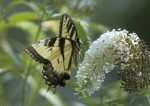
Butterfly Bush is Invasive Do NOT Plant
Invasive Buddleia (Butterfly Bush) I’m sure you’ve all read books about butterfly gardening, and almost every one of them recommends Butterfly Bush (Budleia spp). But did you know that Butterfly Bush is a highly invasive plant and is destroying native butterfly and wildlife habitat? This is a plant from Asia, and now it’s spreading out of control along stream banks and other areas all over the country. How long do you really think we have until Butterfly Bush is listed as invasive in Wisconsin? Or Iowa? Or any of these other states in the middle of this map? ~ Carole Sevilla Brown
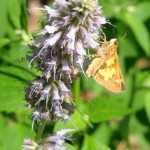
Butterfly Bushes Do NOT Mean More Butterflies
Monarch butterflies only lay their eggs on milkweed (Ascelpias spp.). The availability of larval host plants in your garden is a key component to a sustainable butterfly habitat that is often overlooked. In case you’re wondering, there is not even one species of North American butterfly that uses butterfly bush (Buddleia davidii) as a larval host plant. In addition, butterfly bushes are invasive in many areas so there are definitely better plant choices for a butterfly garden… ~ Debbie Roberts
Best Native Nectar Plants for Monarchs and Other Butterflies
The best plants for Monarchs and other butterflies, as well as all other wildlife in your garden will be locally native to your area. These native plants have a relationship with wildlife that spans thousands of years, contribute to ecosystem services, and provide multiple functions for many species of wildlife. Many indigenous plants are also larval host plants for many species, and many other insects have a variety of uses for them… ~ Carole Sevilla Brown
Plant More Milkweed for Monarchs
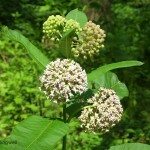
Help Monarchs with the RIGHT Milkweeds
What is it about the Monarch butterfly that inspires such admiration? To help save the Monarchs the spotlight turns now to understanding milkweeds. What do you picture in your mind when you think of one? There are over 100 species of milkweed and many common names are used in association with them. These common names are not consistent from place to place and are frequently shared with plants that are not milkweeds at all. It’s no wonder there is a certain amount of confusion about what to put in the garden! ~ Suzanne Dingwell
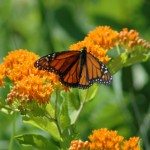
Can Milkweed be Bad for Monarchs?
Milkweed is Bad? We’ve been hearing for years from scientists and Monarch organizations that we need to plant more milkweed to support the phenomenon of Monarch Butterfly migration. But then I read an article where it was advised that milkweed be removed from certain roost sites. So I started to do some research. I wanted to understand why anyone would advise the removal of the milkweed. What I discovered is that some milkweed species are much better than others, some can work to disrupt the Monarch migration, and some can become quite invasive while not supporting new generations of Monarch caterpillars… ~ Carole Sevilla Brown
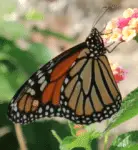

Priority 1: Plant Milkweed this Year
Once again, the news about the numbers of overwintering monarch butterflies in Mexico is grim. It’s not surprising given that the numbers of monarch butterflies seen throughout the country were so low this year. For me, I saw only one monarch caterpillar in my garden this year. While most of us aren’t in a position to influence those habitat loss factors, we can still help the monarch butterflies by creating butterfly habitats in our own gardens.
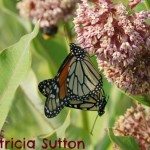

Milkweed for Monarchs
There are over 2,000 species of milkweed in the world. 108-110 milkweed species are native to North America. ONLY 27 of these are used by Monarchs as host plants. Those of us wishing to create Monarch Waystations full of nectar and caterpillar plants need to do our homework to learn which native milkweeds Monarchs will lay their eggs on. Planting species native to your region is key…. ~ Pat Sutton



Butterfly Gardening for Monarchs: Got Milkweed?
An Amazing Migratory Phenomenon Every year 100 million Monarch butterflies make an extraordinary journey, some of them traveling all the way from Canada to the Transvolcanic Mountains in Mexico, where they will spend the winter. In the spring they will mate and head north once again. The female will fly until she locates a patch of milkweed (Asclepias), then lays her eggs and dies. I’ve been in Cape May, NJ during this migration period and the sight of wave after wave of Monarchs floating south above the dunes is a truly breathtaking sight… ~Carole Sevilla Brown
Monarchs Need Milkweed!
Anybody recognize this strange-looking life form? A wad of chewing gum? Plastic toy? Alien? Believe it or not, in just a few days, this odd creature with glowing yellow and black dots will turn into a beautiful monarch butterfly! If you live on the east or west American coast, just by planting any type of milkweed (Asclepias) plants in your garden or yard, you can help these butterflies avoid extinction! ~Ellen Sousa
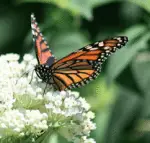

Milkweed
I ask people all the time if they plant milkweed, because it is a host plant for monarch butterflies. Oh yes yes yes, they say, Asclepias tuberosa. Oh no no no, I reply, not good at all. See, in my garden over 5 years, I’ve seen about two monarchs on orange-blooming tuberosa. On incarnata (swamp), I’ve seen one thousand. So the latter is the one to get–not just to help monarchs whose habitats are being poisoned and destroyed like never before (along with pretty much every other butterfly)–but because when it blooms in June and July all insects go nuts nectaring… ~ Benjamin Vogt
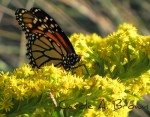


Do Monarch Caterpillars Eat Anything Besides Milkweed
Each time we’ve talked about Monarch Butterflies, I’ve told you about the need to plant more milkweed to help the Monarchs on this journey. So, are we now to think that Monarch caterpillars eat tomato plants because we have found a chrysalis there? Does this dispel everything we’ve learned about Monarchs up to this point? Actually, no. Monarch caterpillars do only eat plants in the Milkweed family… ~Carole Sevilla Brown
Monarch Migration
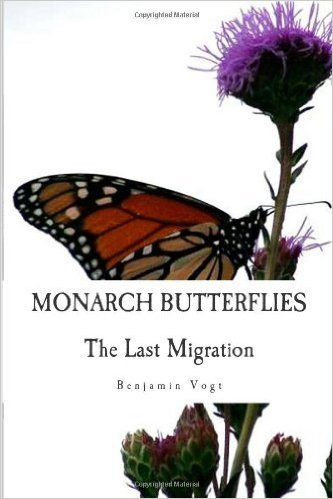

Monarch Butterflies: The Last Migration, by Benjamin Vogt
From 1999-2010, milkweed populations shrank 58% in the Midwest as agriculture adopted genetically modifed (GMO) crops that accept mass spraying of weed killer. And from 1999-2010 monarch egg production dropped by 81% in the Midwest. This now threatened insect migration–one of the largest of its kind in the world, stretching from central Mexico to southern Canada–is a calling out to restore native plants and ecosystems. Only 3% of the original tall grass prairie remains as each backyard becomes a 21st century wildlife refuge. Learn about the monarch–its migration and preferred host / nectar plants–and what you can do ensure its survival.
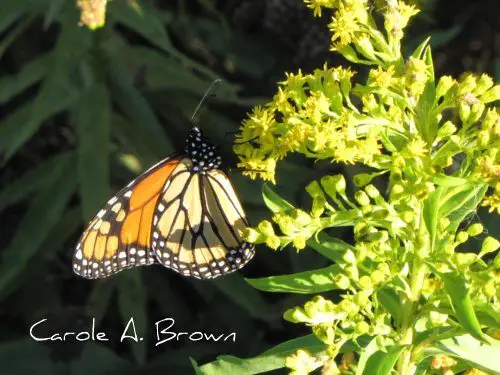

The Monarch Monitoring Project
Hundreds of thousands of Monarch butterflies migrate through Cape May, NJ every year, and thousands of people come from around the world to see them. This spectacle is an amazing phenomenon, but also one which raises a lot of questions. These led to the founding of the Monarch Monitoring Project in 1991 with Richard K. Walton, Louise Zemaitis, and Lincoln Brower. Much is still unknown about the phenomenon that is Monarch Butterfly migration. And there are many conservation concerns that could put this phenomenon in danger… ~Carole Sevilla Brown
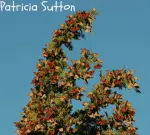

Monarch Migration at Cape May
This fall’s Monarch Migration at Cape May has been magical. Each cold front has brought another wave. Flights on September 23 and 24, 2012, were steady all day long with Monarchs floating down the beachfront from dawn till dusk. Even nasty looking Common Milkweed is still vital to Monarchs, leave it standing through fall And through it all we’re still finding Monarch caterpillars on milkweed, so please, please, please, DO NOT cut down the milkweed in your garden. Despite looking “done” it’s still helping the Monarch population swell… ~ Pat Sutton
Amazing Monarch Migration Phenomenon
On September 18th there was an estimated half million Monarch butterflies in Cape May, NJ, and sadly, I was not there to see it. But, I do have friends in Cape May who shared their story (and photos) of the big day with me. The team of researchers from the Monarch Monitoring Project had been noticing extremely high numbers of Monarchs all day, and they had tagged many of these butterflies as part of their ongoing project which studies the migration path of the Monarchs on their journey to the Trans Volcanic Mountains in Michoacan, to the west of Mexico City…. ~Carole Sevilla Brown
The Monarch Butterfly in the Wildlife Garden
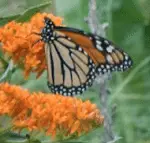

Milkweeds and Their Associated Insects
Monarch butterflies are the insect most frequently associated with Milkweed (Asclepias) species as a larval host. The orange and black coloration of insects associated with Milkweed belong to a group called the “Monarch Mimicry Complex”. Either they feed on milkweed or share the same black and orange coloration as Monarchs that allow them protection from predators. There are other insects who take advantage of the milky sap, or develop ways to ‘eat around’ the sap in order to consume Milkweed leaves… ~ Heather Holm
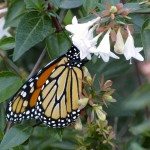

Milkweed Restoration & Monarchs: A Hopeful Story
I’m a plant biologist, not a monarch butterfly specialist. Still, what I’ve observed while restoring the degraded urban creek that runs by my house may offer a hopeful example of the power of native milkweeds to bring back monarch butterflies and the other species in their community. Could we save this “charismatic” insect and its improbable multi-generation migration simply by reestablishing colonies of milkweed, the only food their caterpillars eat? My experience suggests it’s possible…. ~ Susan J. Tweit
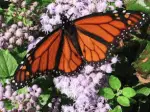

Monarchs and their Enemies
We are told that monarch butterflies are well protected against predators and indeed they are. Their caterpillars feed on milkweeds, rich on highly toxic substances known as cardenolides. Having developed resistance against these chemicals, the monarchs themselves are poisonous so predators avoid them. A young, inexperienced bird that takes a bite off of a caterpillar or a butterfly spits it out in disgust and may be sick afterwards. It learns its lesson after no more than one trial. Are monarchs completely free from enemies, then? Not so, there are exceptions… ~ Beatriz Moisset
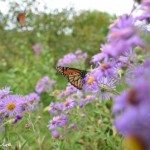

It’s Hard to See the New England Asters For All the Monarchs!
Monarch butterfly migration is well under way. I watched my last Monarch butterfly emerge from its chrysalis four days ago and later in the afternoon held a perfect female out to the large sky so that she might fly and realize her new potential. It is always a thrill for me to watch a butterfly take its first flight. I can never turn away from the magic of this experience to step back into a normal tone of any day . . . the send-offs always paint the remaining hours a golden hue . . . opening imagination that too might soar… ~ Carol Duke
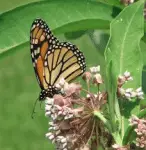

Monarch Butterfly: A Case of Mistaken Identity
The monarch butterfly is, perhaps, the most iconic of all insects. Entomologist Marlin Rice referred to the monarch as the “Bambi of the insect world.” This spectacular butterfly acquired its fame, in part due to a movement devoted to preserve the monarch and its remarkable migration. They are all worthy causes that engage the public; these projects can use the income generated by all the publicity. I applaud the efforts of these organizations. At the same time, I wonder: A poster child is valuable if it raises awareness of a broader issue. The ecological importance of the monarch butterfly is that it is one of many species at risk because of human-caused habitat degradation. Other species may not be as appealing as the poster child, but they deserve our attention, too… ~ Beatriz Moisset



Every fall an amazing phenomenon occurs as millions of Monarch butterflies make their way from across Canada and throughout the US to their wintering sites in the mountain forests of Mexico and select spots in California. They face many perils along this journey as well as in their wintering homes. Here, they are in danger from habitat loss, pesticides, and genetically modified crops. In Mexico logging and destruction of the forests where they spend the winter is a major concern. And that’s where your garden comes in. Your butterfly garden can play a crucial role in ensuring their success in this long migration… ~ Carole Sevilla Brown
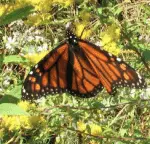

Milkweeds, Monarchs and More: The Milkweed Community
Monarch butterflies capture our hearts with their beauty and intrepid globe trotting. We have learned that the caterpillars need milkweeds to grow into the magnificent winged creatures. As a consequence, many gardeners gladly grow these plants in their yards and welcome the arrival of the travelers. They eagerly follow the appearance of the tiny caterpillars, their growth and final metamorphosis. This leads many to learn more about these plants, their toxicity and the other visitors attracted by the overpowering sweet aroma of the flowers… ~ Beatriz Moisset
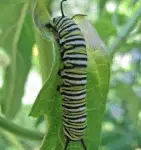

Monarchs in all Forms
For the last two weeks, we’ve had the Monarch Butterfly in three different forms in our yard. There are several adult butterflies that are ecstatic about the Liatris ligulistylis ~ Meadow Blazingstar flowering. It is by far their favorite plant to nectar upon. We have counted up to 18 Monarchs at one time nectaring on this Blazingstar. My husband jokes that he has to fight his way up our walkway through the monarchs this time of year. They also like the Eupatorium purpurem ~ Joe Pye Weed for nectaring… ~ Heather Holm
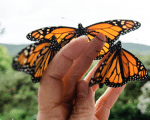

Monarch Butterfly Life Cycle: A Metamorphosis Lift Off Towards Migration
Most days in September I wear butterflies. Above, on a day with soft, fluffy, cotton clouds and blue skies, I release four Monarch Butterflies out the Barn Studio doors into the North Garden. This magical process goes on most of July, August and September. It is with a bit of sadness that I say goodbye to my last Monarch butterfly each year. I spend about a month with each of them until the final emergence and a few hours of knowing the butterflies close up . . . it is being uniquely connected to a special process of life unfolding within our mysterious world of nature. I cherish this seasonal ritual… ~ Carol Duke
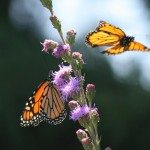

Monarch Magnet: Liatris ligulistylis
Liatris ligulistylis is native to the Rockies, central / northern Plains, and northern Midwest. Some call it Rocky Mountain Blazingstar, some Meadow Blazingstar, others butterfly orgy (mostly me), but the fact is if you want monarchs from egg to butterfly, pair milkweed (my vote is Asclepias incarnata) with Mr. Liatris L. in healthy quantities. I often see 3-5 monarchs clamoring over each other, playing leapfrog, jumping off and hovering only to land again a few inches away–all as they ignore everything else in the garden…. ~ Benjamin Vogt
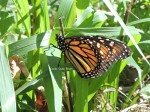

Very Late First Monarch of the Season
But what fascinated me the most was one lone Monarch Butterfly nectaring at the thistle. I realized this was the first Monarch I had seen in Pennsylvania this season, and that is very late to be seeing my first Monarch. There should have been hundreds of them at the refuge, and I should have seen many Monarch butterflies in my own wildlife garden much earlier this spring. And this is very troubling… ~Carole Sevilla Brown
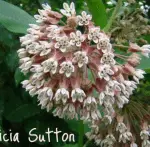

First Monarch, April 16th
As spring unfolds it is always a special day when the first Monarch appears. This Monarch, our first, sailed over our house and into the back yard. Our mid-April garden is mostly spring weeds, which I leave because so little else is in bloom. I’ve been observing elfins and other spring butterflies nectaring on our lush carpet of Chickweed and Purple Dead Nettle . . . so these weeds are keepers for now. The Monarch coursed back and forth and eventually found one of our Milkweed patches. The milkweed was just emerging, only up an inch or two. I didn’t even know it was “up” but this Monarch found it amidst the carpet of weeds. It laid eggs, sailed off, and disappeared from the garden and yard… ~ Pat Sutton
Welcoming Critters: A Monarch Paradise
When I first started my wildlife garden, it was to attract more wildlife into my garden and begin to create a habitat for wildlife. Of course the frogs and toads came right away once the pond went in. Bees and a couple of butterflies flew by as well. But it was the butterflies that I was partial to seeing. I adore their floating motion around the garden. My eyes are trained to spot them even peripherally. And the movement of monarchs are especially identifiable once you see them…. ~Donna Donabella
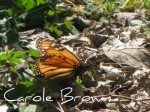

I was thrilled to see my first Monarch Butterfly of the season this year while in Austin, TX to visit the Lady Bird Johnson Wildflower Center. And it reminded me that I want to create a more welcoming habitat for Monarchs in my Pennsylvania wildlife garden this year. It’s really easy to welcome Monarch butterflies into your wildlife habitat garden by adding more milkweed for them, because female Monarchs will only lay their eggs on milkweed plants. It’s the only plant that the caterpillars can eat… ~Carole Sevilla Brown
West Coast Monarchs
Milkweed and Monarchs
Although East Coast and West Coast Monarchs are of the same species, the Milkweed to which they’ve become accustomed is quite different. They have become adapted to different local species of Milkweed, Asclepias. You cannot plant the same species of Milkweed for the Monarchs of the West Coast as for those East of the Rockies. It is important to plant Milkweed for the Monarchs, as it is their host plant… ~Kathy Villim
Monarchs of the West
Every October I think about the Monarch migration to Mexico. And I wonder: where do the West Coast Monarchs go? The winter migration of the Monarchs east of the Rockies is pretty well documented. Much less is known about the winter migration of the Monarchs on the West Coast of North America. Researchers believe that they do not overwinter in Central Mexico and that these Monarchs stay west of the Rockies. While they are the same species (Danaus plexippus), they never meet their east coast cousins…. ~Kathy Villim
Monarchs on Christmas Eve
The magical Season of Christmas is upon us. Scenes of snowy landscapes and star-filled night skies are to be expected in this week’s posts. But here I am in So Cal with no snow to talk about. Instead, I have my own gift to contribute: a visit by a handsome Monarch (Danaus plexippus) on the day before Christmas! Normally, I would spy a Monarch, and he would fly away from me and be gone, long before I could take out my camera, but this one waited for me, flirting, attending to the puffy blossoms of Baccharis salicifolia (commonly called Mule Fat) and flashing his open wings at me. Finally I got his picture… ~Kathy Villim
Butterfly Town
Here I am, as promised, moving up the West Coast to the lovely town of Pacific Grove, next door to the more well-known Monterey, CA. Of course, the Native Gardener would end up in a town named “Butterfly Town”. This town is an overwintering site for the West Coast Monarchs, just like Pismo Beach. the Monarchs East of the Rockies, the West Coast Monarchs do not migrate to Mexico. Instead they stay on the West Coast taking refuge in tall trees on the Coast…. ~Kathy Villim
Overwintering Monarchs, Pismo Beach, CA, Photo by Kathy Vilim
Monarchs in the Wintertime
Walking through the tall stands of Eucalyptus trees, I came upon a Monarch butterfly lying on the ground on some wood chips. He blended in so well, I could easily have stepped on him! But he wasn’t moving. Very carefully, I picked him up and placed him on the side of a Eucalyptus tree. Then I discovered near the base of the tree, that the ground was littered with many, many monarchs! ~Kathy Villim
Butterflies around the country are in danger from habitat loss and pesticide spraying. You have a critical role to play in protecting these beautiful and beneficial pollinators by creating welcoming habitat in your wildlife garden.
When we think of butterfly gardens, we tend to think of lots of nectar plants for adult butterflies, but to have a successful garden for butterflies there is much more to it than that. You need to understand the whole Life Cycle of each butterfly and moth species you want to attract so that you can plan for all of their needs.
You want to stretch the blooming season in your butterfly garden from at least early spring through late fall to provide the most value for these beautiful insects.
More From Ecosystem Gardening:
Submit your review | |

